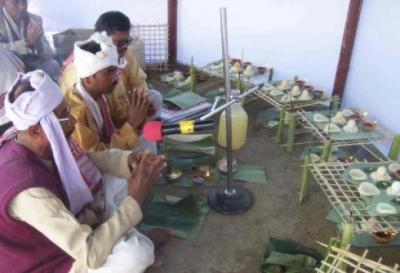|
Here are some instances - King Siu-huim-mong "performed the ceremony of Me-dam Me-phi" (Ahom Buranji, cited above, p. 77). King Gadadhar Singha performed Me-Dam Me-Phi and offered sacrifices to the Ahom gods. (Ahom Buranji, p. 264). Recording the events of King Pramatta Singha (1744-51) the chronicle says "on the 28th of the month of Dinkam (Pausa), on the day of Dap-plao the king left for Charaideo. On the day of Mong-Mao of the month of Din Sam the king worshipped all the Ahom gods" (Ahom Buranji, p. 279). King Rajeswar Singha (1751-69 A.D.) "In the month of Din Sip Song on the day Rai Si-Nga worshipped the Ahom gods at Charaideo. (Ahom Buranji, p. 313). "Me Dam Me Phi still occurs every year at Charaideo", writes Professor B. J. Terwiel, an Anthropologist at present at the Homburg University. (The Tai of Assam, Vol. II, 1981, p.61).
Me-Dam-Me-Phi, the socio-religious festival of the Tai-Ahom goes far beyond the literal meaning of mere ancestor worship as is generally believed. Its antiquity is as old as the great Tai race. Me-Dam-Me-Phi, in Tai-Ahom language, ordinarily means offering oblations and taking care of the dead (ancestors). But looking deep into its philosophy, the celebrations suggest invoking the life force in human life to secure social control for solidarity, vitality in national life at the time of national peril as well as in times of peace and prosperity, successes and failures.
The festival is now a new innovation of the Tai-Ahom as believed by many quarters. In fact, its antiquity dates back to some two thousand years back when Lengdon (the Lord of Heaven) who happened to be the first progenitor of the Tai-Ahom, sent down two of his grandsons Khun-Lung and Khun-Lai to earth to found a state. He advised them to celebrate this festival annually by making offerings and oblations to Him to continue their uninterrupted political hold over the masses. During the days of the Ahom Kings, Me-Dam-Me-Phi celebration was attended by the kings and his ministers and other higher officials as well as a great number of people. It was celebrated at Charaideo, the religious centre of the Ahom kings, with the huge burial mounds (maidams) standing there as a witness. The celebrations at that time lasted for several days.
The observance of Me-dam Me-phi continued. At present the Ahom people observe Me-Dam Me-Phi communally all over Assam on 31st of January each year, and are attended by other people as well. Recognizing the importance of the day, the Government of Assam declares this day as public holiday. |








